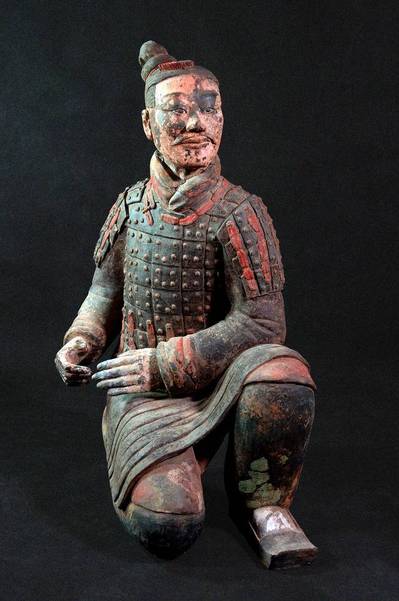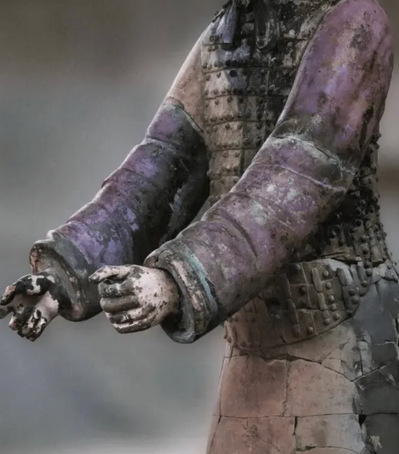Recently, archaeologists at the Emperor Qinshihuang’s Mausoleum Site Museum made an exciting discovery in Pit 2 of the Terracotta Army: a rare senior military officer terracotta figure. This is the first such figure unearthed in Pit 2 since its formal excavation began in 1994. Based on its location within the pit, it is likely to represent the highest-ranking military commander of the unit, commonly referred to as a “General Figure.” To date, only 10 senior officer figures have been found among the Terracotta Warriors.
This year marks the 50th anniversary of the archaeological excavation of the Terracotta Army, and the discovery of the high-ranking officer figure has generated renewed public interest in this extraordinary site. Drawing inspiration from the Terracotta Army, professors Wang Zhu-Jun and Liu Zhi from the School of Physical Science and Technology at ShanghaiTech University have leveraged advanced electron microscopy (EM) and imaging techniques in materials science and cultural heritage preservation, aiming to foster the integration of archaeology with natural and human sciences.
The origins of Chinese Purple and related research
Purple has historically been one of the rarest and most elusive colors in the natural world. No naturally occurring purple pigment has ever been identified. Professor Liu Zhi’s fascination with this unique color began during his visit to the Terracotta Army in 2003, where he saw a kneeling archer figure wearing a purple skirt. The purple seen on these warriors, known as “Chinese Purple” or “Han Purple,” was an artificial synthetic pigment. This sparked Liu’s deep interest in this enigmatic color, and along with Assistant Professor Wang Zhu-Jun, he began to delve into the study of Chinese Purple using EM.

Kneeling archer figure
Historical insights
According to Wang, the identification of Chinese Purple, Chinese Blue, and Chinese Dark Blue was initially made by researchers outside China, with only Chinese Dark Blue involving a Chinese co-discoverer, Xia Yin. In 1997, researchers outside China successfully synthesized Chinese Purple and identified it as the earliest man-made quantum material—a material that exhibits discrete energy states under specific conditions.

Chinese Purple on charioteer figure
The research team at ShanghaiTech analyzed the purple pigment founded on the Terracotta Warriors and concluded that this synthetic technology dates back to the Warring States period. Chinese Purple, characterized by its unique structure, was widespread from the Spring and Autumn period through the Han Dynasty but disappeared by the Eastern Han Dynasty. Its production spanned approximately 900 years, with the quality varying according to the social status of the users. During the Qin Dynasty, black, purple, and red were dominant colors in clothing, with purple primarily produced through official commissioned firing techniques. Although Qin artisans did not understand the microscopic structure of the pigment, they had mastered the synthesis of Chinese Purple using a method involving saltpeter and related minerals. Testing of pigment samples from Qin and Han tomb showes a purity of about 30%, while the purple pigment on Terracotta Warriors reached a remarkable purity of over 95%. Notably, official kilns dedicated to producing purple pigments in China only emerged during the Song Dynasty.
Modern synthesis efforts
Around 2000, international research on Chinese Purple were published, but these primarily relied on hydrothermal synthesis methods, differing from the ancient Qin-era techniques.
At ShanghaiTech, researchers have now succeeded in synthesizing 100% pure Chinese Purple by employing EM technology. “Our recent observations using EM revealed that Chinese Purple consists of barium copper silicate, which is consistent with the composition identified in international studies around 2000. We also discovered that Qin artisans had already mastered the ability to control the synthesis process,” said Wang. “Our team is currently experimenting by placing the raw materials needed for synthesizing Chinese Purple into an EM, using chemical methods to observe the nucleation and growth of crystals at the atomic scale. By understanding these mechanisms, we aim to reverse-engineer the ancient Chinese synthesis methods and recreate the exact conditions required to synthesize the pigment. Using this approach, we can now synthesize Chinese Purple at purities of 85%, 95%, and even 100%.”
Applications in archaeology and cultural heritage
Wang emphasized the broader applications of this research: “In the field of cultural heritage preservation, challenges such as understanding the glaze techniques of Yaozhou pottery or the casting processes of bronze artifacts can be addressed using EM. We provide atomic-scale information, and it’s up to archaeological experts to determine how to apply this knowledge.”
In recent years, ShanghaiTech has collaborated with the Palace Museum and the Emperor Qinshihuang’s Mausoleum Site Museum on research of Chinese Purple. The research results are expected to be published in the spring of 2025.

